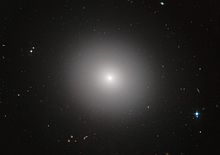GW170817
| NGC 4993 | |
|---|---|

Typical elliptical galaxy
|
|
| Observation data | |
| Constellation | Hydra |
| Right ascension | 13h 09m 47.2s |
| Declination | −23° 23′ 4″ |
| Distance (comoving) | 40 Mpc (130 Mly) |
| Characteristics | |
| Type | galaxy, E/S0 |
NGC 4993 (also catalogued as NGC 4994) is an elliptical galaxy in the constellation Hydra, discovered in 1789 by Wilhelm Herschel. In August 2017, astronomers reported that a short gamma-ray burst, of the sort conjectured to be emitted in the collision of two neutron stars, was detected in this galaxy. A gravitational wave event has been rumored to have been detected in association with this burst. If verified, its waveform could provide direct confirmation that binary neutron star collisions produce short gamma-ray bursts.
GRB 170817A is a gamma-ray burst (GRB) detected by NASA's Fermi and ESA's INTEGRAL on 17 August 2017. A gravitational wave signal, with an optical counterpart, was rumored to have been observed by the LIGO/Virgo collaboration at the same time. The rumor first went public on 18 August 2017, tweeted by astronomer J. Craig Wheeler of the University of Texas at Austin. He later deleted the tweet and apologized. Others have followed up, and reported that the public logs of several major telescopes (HST, Chandra, ALMA, VLT) list priority interrupts in order to observe NGC 4993, with one record naming a gravitational wave followup as the reason. The collaboration has declined to comment on the rumors, merely updating a previous announcement that there were seven triggers under analysis (as of 7 July 2017) to an unspecific "some" (as of 25 August 2017).
...
Wikipedia
